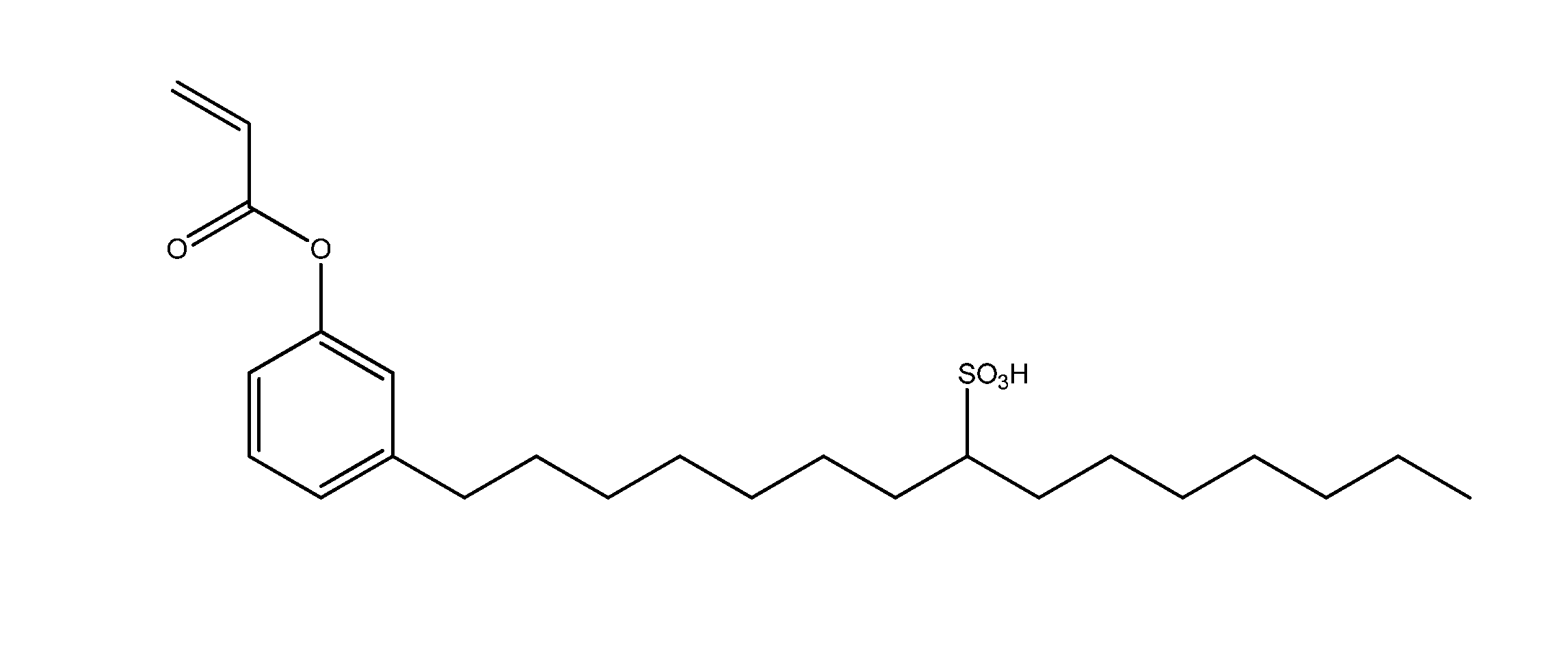Method for preparing biomass-based polymer emulsion
a biomass-based polymer and emulsion technology, applied in the direction of adhesive types, graft polymer adhesives, coatings, etc., can solve the problems of poor film forming properties, large particle size of waterborne polyurethane, low film hardness, etc., to enhance the overall properties of polyurethane emulsion, reduce the dependence on oil resources, and reduce production costs
- Summary
- Abstract
- Description
- Claims
- Application Information
AI Technical Summary
Benefits of technology
Problems solved by technology
Method used
Image
Examples
example 1
[0034]1) Preparation of Cardanol-Based Polymerizable Emulsifier
[0035]3 g of cardanol purchased from the market was completely dehydrated under vacuum for an hour, and dissolved in 20 mL of a mixed solvent of tetrahydrofuran and water with a volume ratio thereof of 1:1 at room temperature, followed by addition of 2 g of Na2S2O5 and 0.4 g of sodium hydroxide. The resulting mixture was allowed to react at 80° C. for 6 hours, and then cooled to room temperature. Thereafter, the pH value of the mixture was adjusted using chlorhydric acid to 5, and then the mixture was allowed to react at 150° C. for 3 hours. After the reaction, the mixture was cooled to room temperature, allowed to stand overnight, filtered, and washed with 10 mL of tetrahydrofuran (5° C.) to yield a white solid, which was dried, and dissolved in 10 mL of anhydrous dichloromethane, and followed by addition of 1 g of acryloyl chloride and 1.1 g of triethylamine. The solution was allowed to react at 5° C. for 0.5 hour, to ...
example 2
[0041]1) Preparation of Cardanol-Based Polymerizable Emulsifier
[0042]3 g of cardanol purchased from the market was completely dehydrated under vacuum for an hour, and dissolved in 20 mL of a mixed solvent of tetrahydrofuran and water with a volume ratio thereof of 1:1 at room temperature, followed by addition of 1.8 g of Na2SO3 and 0.6 g of sodium hydroxide. The resulting mixture was allowed to react at 80° C. for 6 hours, and then cooled to room temperature. Thereafter, the pH value of the mixture was adjusted using chlorhydric acid to 5, and then the mixture was allowed to react at 150° C. for 3 hours. After the reaction, the mixture was cooled to room temperature, allowed to stand overnight, filtered, and washed with 10 mL of methonal (0° C.) to yield a white solid, which was dried, and dissolved in 10 mL of anhydrous acetonitrile, and followed by addition of 1.1 g of acryloyl chloride and 1.0 g of triethylamine. The solution was allowed to react at 5° C. for 24 hours, to yield a...
example 3
[0048]1) Preparation of Cardanol-Based Polymerizable Emulsifier
[0049]3 g of cardanol purchased from the market was completely dehydrated under vacuum for 2 hours, and dissolved in 20 mL of a mixed solvent of alcohol and water with a volume ratio thereof of 1:1 at room temperature, followed by addition of 3.0 g of Na2S2O5 and 0.8 g of potassium hydroxide. The resulting mixture was allowed to react at 70° C. for 6 hours, and then cooled to room temperature. Thereafter, the pH value of the mixture was adjusted using chlorhydric acid to 6, and then the mixture was allowed to react at 70° C. for 2 hours. After the reaction, the mixture was cooled to room temperature, allowed to stand overnight, filtered, and washed with 10 mL of acetone (3° C.) to yield a white solid, which was dried, and dissolved in 10 mL of anhydrous tetrahydrofuran, and followed by addition of 1.2 g of methacryloyl chloride and 1.5 g of triethylamine. The solution was allowed to react at 0° C. for 24 hours, to yield ...
PUM
| Property | Measurement | Unit |
|---|---|---|
| Temperature | aaaaa | aaaaa |
| Temperature | aaaaa | aaaaa |
| Temperature | aaaaa | aaaaa |
Abstract
Description
Claims
Application Information
 Login to View More
Login to View More - R&D
- Intellectual Property
- Life Sciences
- Materials
- Tech Scout
- Unparalleled Data Quality
- Higher Quality Content
- 60% Fewer Hallucinations
Browse by: Latest US Patents, China's latest patents, Technical Efficacy Thesaurus, Application Domain, Technology Topic, Popular Technical Reports.
© 2025 PatSnap. All rights reserved.Legal|Privacy policy|Modern Slavery Act Transparency Statement|Sitemap|About US| Contact US: help@patsnap.com

